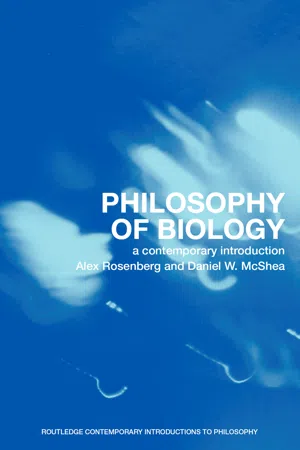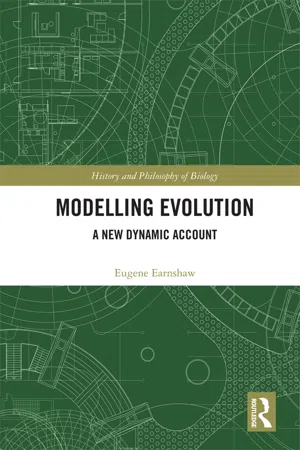Biological Sciences
Genetic Drift
Genetic drift refers to the random fluctuation of allele frequencies in a population due to chance events. It is a mechanism of evolution that can lead to the loss of genetic variation over time. Genetic drift is more pronounced in small populations and can result in the fixation of certain alleles, leading to reduced genetic diversity.
Written by Perlego with AI-assistance
Related key terms
6 Key excerpts on "Genetic Drift"
- eBook - ePub
- John H. Relethford(Author)
- 2012(Publication Date)
- Wiley-Blackwell(Publisher)
. We can also use probability theory to make some general statements about the likelihood of a set of events occurring. For example, if we flip 10 coins, how many will come up heads? We might be very lucky and get 10 heads. We could also get 9 heads and 1 tail. The other possibilities are 8, 7, 6, 5, 4, 3, 2, 1, or 0 heads. Although we cannot tell beforehand what the specific outcome of any given toss of 10 coins will be, we can derive the probability of the occurrence of any of those outcomes. For example, the probability of getting all heads from 10 coin flips is roughly one in 1000 (0.000977), and the probability of getting 5 heads out of 10 coin flips is 0.246 (see any introductory statistics book for an explanation of how to do this).Genetic Drift is also a random process. Here, allele frequencies can fluctuate from generation to generation because of chance. Under Hardy–Weinberg equilibrium, we expect allele frequencies to remain constant from one generation to the next in the absence of mutation, selection, or gene flow. As noted in Chapter 2, an assumption of Hardy–Weinberg equilibrium is an infinite population size so there is no sampling deviation. In the real world, there are sampling deviations, and allele frequencies can increase or decrease by chance. As with coin flips, we cannot predict beforehand exactly what will happen as a result of Genetic Drift, but the principles of probability allow us to figure out the likelihood of different events occurring.5.1 What is Genetic Drift?Although it is easy to give the definition of Genetic Drift as a random fluctuation in allele frequencies over time, it is more difficult to get a feel for what this actually means in an evolutionary context. We will start by considering the effect of sampling in a genetic context and then build to an example of Genetic Drift.5.1.1 Genetic SamplingLet us start with a simple example. Assume that there is a locus with two alleles, A and a , and that you have the heterozygous genotype Aa . When you have a child, you will pass along either the A allele or the a allele. Each event has a 50% chance of happening. Therefore, you might expect to pass on the A allele half of the time and the a allele half of the time. Now, suppose that you have four children. How many children do you expect to receive the A allele? Although your expectation would be to have two children with the A allele and two children with the a - eBook - ePub
Worldviews
An Introduction to the History and Philosophy of Science
- Richard DeWitt(Author)
- 2018(Publication Date)
- Wiley-Blackwell(Publisher)
Although the process of genetic reproduction is more complex than the simple scenario involving the colored balls, it nonetheless involves the same sort of sampling, though in the case of genetic reproduction the sampling involves alleles. Whereas with the colored balls we saw drift resulting in a change in the frequencies of colors over time (that is, over successive generations), with biological populations we can expect drift to result in a change in allele frequencies in a population over time. Or in other words, drift will result in evolution in that population.A few additional notes are in order before closing our discussion of Genetic Drift. First, population size and the relative size of samples tend to have a substantial effect on the amount of drift we would expect to occur. The larger the population, and the larger the sample size, the less drift we would expect. Likewise, smaller populations, as well as smaller sample sizes, are more likely to result in dramatic drift. Notice that the sample size in the colored balls scenario was 20% (that is, we sampled 20 balls out of a total of 100), which is relatively small, and thus the somewhat dramatic drift we saw was not that surprising. Nonetheless, as long as there are gene variants (different alleles) in a population, then unless a sample size is 100% (which for all practical purposes will not happen in biological populations), Genetic Drift will occur. And as noted, Genetic Drift is now understood to be an important mechanism in evolution.It is also worth noting that it is difficult (perhaps for all practical purposes impossible) to determine how much change in a population is due to Genetic Drift. This is because changes in a population over time due to Genetic Drift, versus changes due to natural selection, are difficult (perhaps practically impossible) to distinguish. Thus, while there is widespread recognition that both natural selection and Genetic Drift play important roles in evolution, there is some disagreement over how much of a role each plays.Finally, two subtypes of Genetic Drift are worth noting, usually termed bottleneck effects and founder effects - eBook - ePub
Philosophy of Biology
A Contemporary Introduction
- Alex Rosenberg, Daniel W. McShea(Authors)
- 2007(Publication Date)
- Routledge(Publisher)
probably result in population differences. The “probably” in the PNS reflects the fact that when populations are small, chance will sometimes result in the less fit increasing. For the same reason, chance allows for a fair coin coming up tails six times in a row. Of course contemporary evolutionary biology denies none of Gould and Lewontin’s claims about drift. The biological problem is to what extent random drift—probability, chance, luck—is a factor in the actual course of descent with modification that constitutes evolution here on Earth. Some biologists have argued that explaining the actual course of evolution demands a significant role for drift. Others have denied this. Lewontin and Gould are just two of the biologists in the first group. But even among those who doubt that drift is generally an important factor, it is considered likely to be important in certain evolutionary processes, like speciation. One recognized mechanism of speciation is geographic isolation. In one version, the process begins with the emergence of some new geographic barrier, perhaps a new seaway or mountain range that separates a small number of members of one species from the rest of a large population. This small population then reproduces in isolation from the larger parent population, owing to the barrier that separates them. If the founder population is small it probably does not carry the full range of genetic variation in the large population. Further, in small populations new combinations of genes are likely to arise, producing new phenotypes, which may become fixed by chance. Eventually, given sustained isolation of the founder population, a new species emerges. More generally, in populations of any size, chance can change the distribution of traits from generation to generation. Such changes that do not take populations in the direction of greater adaptation are often described as resulting from drift. That such changes can and do occur is uncontroversial. But their importance in determining the evolutionary trajectories of most species, most of the time, is an empirical issue that is much debated.The philosophical problems of drift arise from competing understandings of how drift works and what its sources are: Is drift a separate evolutionary force or cause that combines with selection, a second independent force, to determine evolutionary trajectories? Biologists often assume this interpretation of drift, especially when they accept the role of drift as running counter to that of selection, slowing it down, or preventing it from working altogether in determining evolutionary outcomes. Another view treats drift not as a distinct factor in evolution, but as an inseparable reflection of the character of natural selection as a population-level process. In this conception, drift is always present in evolution, even in a fully deterministic world, owing to the fact that natural selection is a statistical process that operates only on populations and is not reducible to the heritable fitness differences between individual competing organisms. On this view, drift, like entropy in thermodynamics, is a property of ensembles or populations that disappears when we focus on individual organisms (just as entropy disappears when we focus on the individual particles of a gas enclosed in a container). Still a third view we should consider, if only to illustrate the problems drift raises for the theory of natural selection, treats drift as a reflection of our ignorance of all the selective forces that together determine unique evolutionary outcomes. These utterly different understandings of drift make for very different interpretations of how the theory of natural selection is to be understood, as we shall see. - eBook - ePub
Modelling Evolution
A New Dynamic Account
- Eugene Earnshaw-Whyte(Author)
- 2018(Publication Date)
- Routledge(Publisher)
Such a process is called Genetic Drift. It involves both mortality and reproduction, because each time the process operates new individuals enter the population by birth and all the previously extant individuals die. It is intended primarily to represent the evolutionary effects of genetic segregation during meiosis, where one out of the two chromosomes of the parent is randomly given to the gamete. Although the representation is (as always with population genetics) very abstract, we can understand it as aggregating all births together with deaths due to ‘natural causes’ – that is, deaths that are of mature organisms that have had their opportunity to reproduce. Population genetics may model evolution via Genetic Drift alone for some purposes, or it can be combined with other evolutionary processes in a more complex model.Genetic Drift in population genetics may be contrasted with a process of selection, modelled as a difference in relative growth rate between the favored trait and the alternatives. A typical expression will assign growth rates to each genotype, modelling a deterministic change from one generation to the next in the prevalence of each trait. This can be understood as, for example, aggregating premature deaths from all sources, assuming that the different growth rates are because some genotypes are more likely to die between infancy and adulthood. The specific interpretation of the underlying evolutionary events is not particularly important and is not usually specified or discussed; it is important to us only because I wish to emphasize that it is distinct from the events that underlie Genetic Drift. Both selection and Genetic Drift are at the individual level composed partly of mortality events; however, these will be systematically different – about as different, ideally, as a salmon dying from an infection is different from a salmon dying after spawning.Mutation in population genetics represents genetic level incidents where a new allele enters the population via the alteration of an existing allele. It is usually modelled as a rate of incidence, in contexts where population sizes are large enough that it can be treated in many respects as deterministic. Once again, it amalgamates evolutionary events that are different in kind from those treated by drift and selection.The evolutionary processes implicitly modelled by population genetics are well suited to its formal explanatory needs, which prioritize generality and tractability over detailed and valid causal analysis. So, for example, there is no biological population where the genotype of the offspring is generated by sampling twice from the total pool of parent genes. This abstracts away from mating patterns and biological sex, but these idealizations are helpful because the losses in validity are small and outweighed by the simplicity and elegance of the resulting models. - eBook - ePub
- Matthew Hamilton(Author)
- 2011(Publication Date)
- Wiley-Blackwell(Publisher)
The random nature of Genetic Drift can be seen by the zig-zag changes in allele frequency that have no apparent direction. Allele frequencies that reach the upper or lower axes represent cases of fixation or loss. In the bottom panels, the genotype frequencies are shown for the allele frequencies represented by the black and blue lines under the assumption of random mating within each generation. The changes in genotype frequencies are a consequence of changes in allele frequencies due to Genetic Drift. The bottom panels of Fig. 3.3 show genotype frequencies based on random mating for one of the populations represented in the top panels. Genetic Drift clearly causes genotype frequencies to change over time along with the changes in allele frequency. This is in contrast to the processes considered in Chapter 2, such as consanguineous mating, that result in changes in genotype frequency only but do not alter allele frequency. Genetic Drift is most commonly modeled and demonstrated from the perspective of allele frequencies since it is easier to summarize a diallelic locus in a population as two allele frequencies rather than three genotype frequencies. But remember that genotype frequencies are affected by Genetic Drift too, and genotype frequencies can always be obtained by multiplication given allele frequencies under the assumption of random mating. Figure 3.4 The results of Genetic Drift with different initial allele frequencies. The two panels have identical population sizes (N = 25) but initial allele frequency is p = 0.2 on the right and p = 0.8 on the left. The chances of fixation are equal to the initial allele frequency, a generalization that can be seen by examining a large number of replicates of Genetic Drift. Consistent with this expectation, more replicates go to loss on the left and more reach fixation on the right - eBook - ePub
- Mark Stoneking(Author)
- 2016(Publication Date)
- Wiley-Blackwell(Publisher)
One can come up with fancier models, for example, allowing for different rates of migration between different populations, but the overall outcome will be the same: the allele frequency differences among populations will become smaller and smaller over time. If we turn now to our two questions of interest, what does migration do in terms of genetic variation within populations and genetic differences among populations? Keep in mind our infinite alleles model of mutations: we have several populations, so the mutations occurring in each population are going to be different. Migration will spread these mutations around among the different populations, hence the genetic variation within each population will be increased (relative to what it would be without migration). And, it should be easy to see that genetic differences among populations are going to decrease with migration—over time, we expect the allele frequencies in the populations to converge to some average value. Migration and Genetic Drift As we saw previously, with small population sizes Genetic Drift will increase homozygosity, leading to an increase in genetic differences among populations. Migration, on the contrary, counteracts this effect of Genetic Drift by decreasing the genetic differences among populations. What happens when we have both Genetic Drift and migration: which one “wins”? This situation turns out to be very similar in principle to the case discussed above of mutation versus Genetic Drift, and the relevant equation should look very familiar (with the derivation, for those of you interested in such details, in Box 5.5): where is the usual inbreeding coefficient, that is, the probability that two alleles chosen at random are identical by descent. So, if is low, then migration has won (because migration is keeping homozygosity due to identity by descent low); if is high, Genetic Drift has won (because Genetic Drift is keeping homozygosity due to identity by descent high)
Learn about this page
Index pages curate the most relevant extracts from our library of academic textbooks. They’ve been created using an in-house natural language model (NLM), each adding context and meaning to key research topics.





